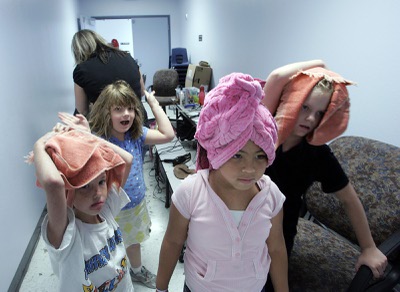
First grader Jolie, right, gets a free haircut Friday at Whitney Elementary School. Students also get supplies, basic health care and clothing at school.
Tuesday, June 3, 2008 | 2 a.m.
Sun Archives
- In school, but without a home (2-13-2008)
- Volunteers work to make life better for poor students (1-10-2007)
- Donation a shoe-in for students in need (10-25-2005)
On her first day as principal at Whitney Elementary School more than four years ago, Sherrie Gahn noticed students in the lunch line were loading up their pockets with plastic ketchup packets.
A cafeteria worker explained to Gahn that the kids were taking the ketchup home so they would have something to eat for dinner.
“From that point on, no matter where I went, I started telling people about my kids,” Gahn said. “Someone has to be a voice for them.”
When she took the job, Gahn had known her school, near Tropicana Avenue at Boulder Highway, served the low-income housing and weekly motels of the surrounding East Las Vegas neighborhood. What she hadn’t known was that most of her 650 students were homeless or teetering on the brink.
The federal government defines a homeless person as anyone who lacks “a fixed, regular and adequate nighttime residence,” and as of May, the Clark County School District had more than 4,000 students who fit that bill, up from about 3,500 a year ago. The county’s social service agencies and organizations concur that there are thousands more needy kids out there who have not yet been identified as homeless.
Many Whitney students walk to school from tiny homes that shelter multiple families. Some have no electricity, heat or running water, Gahn has learned.
About 85 percent of Whitney students qualify for free or reduced-price meals, and Gahn figures about that percentage fit the federal definition of homeless. For the 2008-09 academic year Whitney will be eligible for additional federal funding because of the increase in its needy student population. The school was rezoned last year, and there was a chance students from the weekly motels would be sent elsewhere. But Gahn fought to keep them at Whitney.
“We didn’t want to set them up to worry about what would happen to them,” Gahn said. “They deserve something constant in their lives.”
The extra federal dollars will help next year, Gahn said, but the kids still need to get through the summer. There isn’t much of a discipline problem at Whitney, except when school vacations and summer break arrive.
“That’s when we see kids start to act out,” Gahn said. “We talk to them and reassure them that there will still be help available.”
The help includes summer meals at a nearby community center and a School District counselor who will continue meeting individually with troubled students.
“Some of these kids are in crisis mode emotionally,” Gahn said. “We need to make sure they don’t feel like we’ve dropped the ball with them just because it’s summer.”
Many of the students are “second- and third-generation poverty,” Gahn said. “They don’t know there’s anything different or better. We try to teach them that they are people of character and that this experience does not define them. They can grow up to be anything they want to be, and this is just one of the hurdles they have to face.”
The school does what it can to provide necessities such as food and clothing, and to direct families to other resources. Gahn has hired several mothers to work in the cafeteria and the front office, and as classroom aides. The campus also offers classes in parenting skills and English as a second language.
Gahn knows many of Whitney’s programs go beyond what might be expected of a traditional school. But “the academics won’t come if a child is hungry, or has a stomachache, or needs eyeglasses,” Gahn said. “I take care of that with my school counselor and take that off the teacher’s plate. Then hopefully the teacher has more time to actually teach, and the child is in a better position to learn.”
Since Gahn arrived and began adding supplemental services, student test scores have climbed steadily. For the 2006-07 academic year, 55 percent of her students were proficient in reading, writing and math, compared with only 25 percent four years earlier.
There are local programs that help needy students, such as Operation School Bell, run by the Assistance League of Las Vegas, which outfits thousands of children with clothing and classroom supplies. Several organizations, including Corps of Compassion, deliver backpacks of nutritious snacks so students will have food for the weekend. The district also has several on-campus health clinics that provide free care.
But Whitney’s staff has gone a step further, taking a grass-roots approach to filling the gaps that persist.
Two years ago Whitney began receiving 181 backpacks a week from Corps of Compassion after it was one of the first schools to sign up with the group. This year, only 50 backpacks could be delivered because so many other schools had filed requests.
Gahn decided Whitney would make up the difference for its students. She estimates the school spends about $1,000 each month filling 150 backpacks, and there’s a need for at least 100 more. The grocery money comes from community groups and individuals, as well as from Gahn’s own pocket.
Then there are the donated goods and services, which come in from a variety of sources. The Fraternal Order of Eagles provides pizza and cake for the monthly birthday parties. Station Casinos brought over toys for holiday presents. A local lawyer and a real estate company have stocked the school’s cupboards with nonperishable food. Students are taken for eye exams, hearing tests and routine checkups.
Juan, a second grader, got his first pair of glasses this year. He says he can see the blackboard now. Stephanie, a first grader, didn’t know there was anything wrong with her eyes until she was taken for an exam a few months ago. She leaves her glasses in her desk at the end of the school day to make sure nothing happens to them.
Recently, Gahn and Vicki Bustos, the school’s counselor, went shopping for shoes. They bought 560 pairs, cleaning out discount stores all over town.
“I felt bad for the people who were behind us in the checkout line,” Gahn said, laughing.
Similar stories of generosity are playing out at other district campuses, and dozens of community groups are providing volunteers, supplies and money. But the population of at-risk students continues to grow. Whitney is an example of a school that’s garnered significant community support, thanks to the relentless advocacy of its principal and staff. The challenge is to find similar supporters for the dozens of other needy campuses.
“We have some wonderful community partners, but not enough to go around,” said Sue Goldman, a facilitator in the district’s outreach program for homeless students. “We’re trying to teach schools to help themselves and think creatively, because our resources are really stretched to the limit.”
Last week, the small annex of Whitney’s multipurpose room was transformed into a salon by hairstylists Kari Thormodsgaard and Danielle Diaz.
Thormodsgaard said she’s known Gahn for several years, and immediately agreed to cut the students’ hair when asked.
“I think a lot of people would help out but they don’t know how, or they don’t know how bad things are,” Thormodsgaard said. “Until Sherrie mentioned it, it didn’t occur to me that there was anything I could do personally.”
Climbing onto the chair, first grader Xavier told Thormodsgaard his grandmother usually cuts his hair. Thormodsgaard suggested trimming the sides and thinning the top, keeping the shorter spikes that rise over his forehead.
“Does that sound good?” she asked.
He nodded, and she turned to her supplies. The clippers hummed and Thormodsgaard kept up the cheerful chatter. How old are you? Are you looking forward to summer? What are you going to do for vacation? Do you like school?
Fifteen minutes later, Xavier climbed down, his hair neatly tamed with the help of a little styling gel and Thormodsgaard’s coaxing fingers.
“Tell your grandma I think she’s doing a good job on your hair, OK?” the stylist said.
In the opposite chair, Jolie, 7, told Diaz she wanted her hair cut much shorter. Picking up a dark-brown lock from well below the girl’s shoulder, Diaz waited until school counselor Bustos checked the girl’s permission slip and gave the OK.
Within minutes, Jolie’s hair swung in a curve just below her chin.
“Do you like it?” Diaz asked.
Jolie gazed at her reflection in the handheld mirror, barely able to contain her delight. Heading back to class she bounced on her toes, bunny-hopping across the floor.
For more information, call the School District’s Title I HOPE program at 855-6682.


Join the Discussion:
Check this out for a full explanation of our conversion to the LiveFyre commenting system and instructions on how to sign up for an account.
Full comments policy